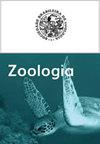牛蛙三个发育阶段的心率反应和双峰气体交换
IF 1.8
4区 生物学
Q4 ZOOLOGY
引用次数: 0
摘要
测量发育中的动物的心肺变量可能具有挑战性,特别是当它们使用双峰气体交换来维持代谢活动时。蝌蚪在水中呼吸时通过被膜和鳃进行气体交换,在空气中呼吸时通过肺进行气体交换,在发育过程中每种呼吸结构的贡献各不相同。水生和空气呼吸之间的相互作用导致复杂的生理反应,可能影响心脏周期。测量anurans在其发育过程中的心率(fH)以及水生和空中气体交换可能具有挑战性,因为它可能涉及处理小动物和/或一定程度的侵入性(即植入电极的手术)。在这里,我们同时评估了牛蛙Lithobates catesbeianus发育三个阶段的水生和空中气体交换、肺通气和fH (Shaw, 1802)。我们建立了一种新颖的、无创的、封闭的呼吸测量系统,能够同时测量不同体型动物的空气和水生气体交换。我们的综合分析显示,在牛蛙的发育阶段,心率下降,耗氧量增加,但在呼吸空气后或呼吸过程中心率没有调整。此外,变态蝌蚪在空气中的耗氧量高于在水中的耗氧量,而水中呼吸负责释放二氧化碳。我们的结果与文献中发现的结果一致,但我们的研究代表了第一个同时评估双峰气体交换和心率的非侵入性研究。此外,我们的装置具有进一步发展的潜力,可以控制水和空气的成分。这个工具可以极大地促进心肺生理学对不同环境条件的反应的研究。本文章由计算机程序翻译,如有差异,请以英文原文为准。
Heart rate response and bimodal gas exchange in three developmental stages of the bullfrog Lithobates catesbeianus (Anura: Ranidae)
Measuring cardiorespiratory variables can be challenging in developing animals, especially when they use bimodal gas exchange to maintain metabolic activity. In tadpoles, gas exchange may occur through the integument and gills when breathing in the water and through the lungs when breathing air, with varying contributions of each respiratory structure during development. The interaction between aquatic and air breathing results in a complex physiological response that may affect the cardiac cycle. Measuring the heart rate (fH) together with aquatic and aerial gas exchange in anurans during their development can be challenging, since it may involve handling small animals and/or a certain degree of invasiveness (i.e., surgery to implant electrodes). Here, we evaluated concomitantly aquatic and aerial gas exchange, lung ventilation, and fH in three stages of development of the bullfrog Lithobates catesbeianus (Shaw, 1802). We built a novel, noninvasive, closed respirometry system capable of measuring fH, aerial and aquatic gas exchange simultaneously in animals of different sizes. Our integrative analysis revealed a decrease in the heart rate and an increase in oxygen consumption during the developmental stages of the bullfrog, but there was no adjustment of heart rate after or during air breathing. Moreover, tadpoles in metamorphosis showed higher oxygen consumption in air than in water, while aquatic breathing was responsible for releasing CO2. Our results are consistent with those found in the literature, yet our study represents the first non-invasive investigation to evaluate bimodal gas exchange and heart rate simultaneously. Moreover, our setup holds potential for further advancements that would allow for controlled water and air composition. This tool could greatly facilitate the investigation of how cardiorespiratory physiology responds to varying environmental conditions.
求助全文
通过发布文献求助,成功后即可免费获取论文全文。
去求助
来源期刊

Zoologia
生物-动物学
自引率
0.00%
发文量
15
期刊介绍:
Zoologia, the scientific journal of the Sociedade Brasileira de Zoologia (SBZ), is an international peer-reviewed, open-access Zoological journal that publishes original research on systematics, evolution, taxonomy, nomenclature, biogeography, morphology, physiology, biology, ecology, symbiosis, conservation, behavior, genetics and allied fields. The journal, formerly known as Revista Brasileira de Zoologia, publishes original articles authored by both members and non-members of the Society. The manuscripts should be written exclusively in English.
 求助内容:
求助内容: 应助结果提醒方式:
应助结果提醒方式:


